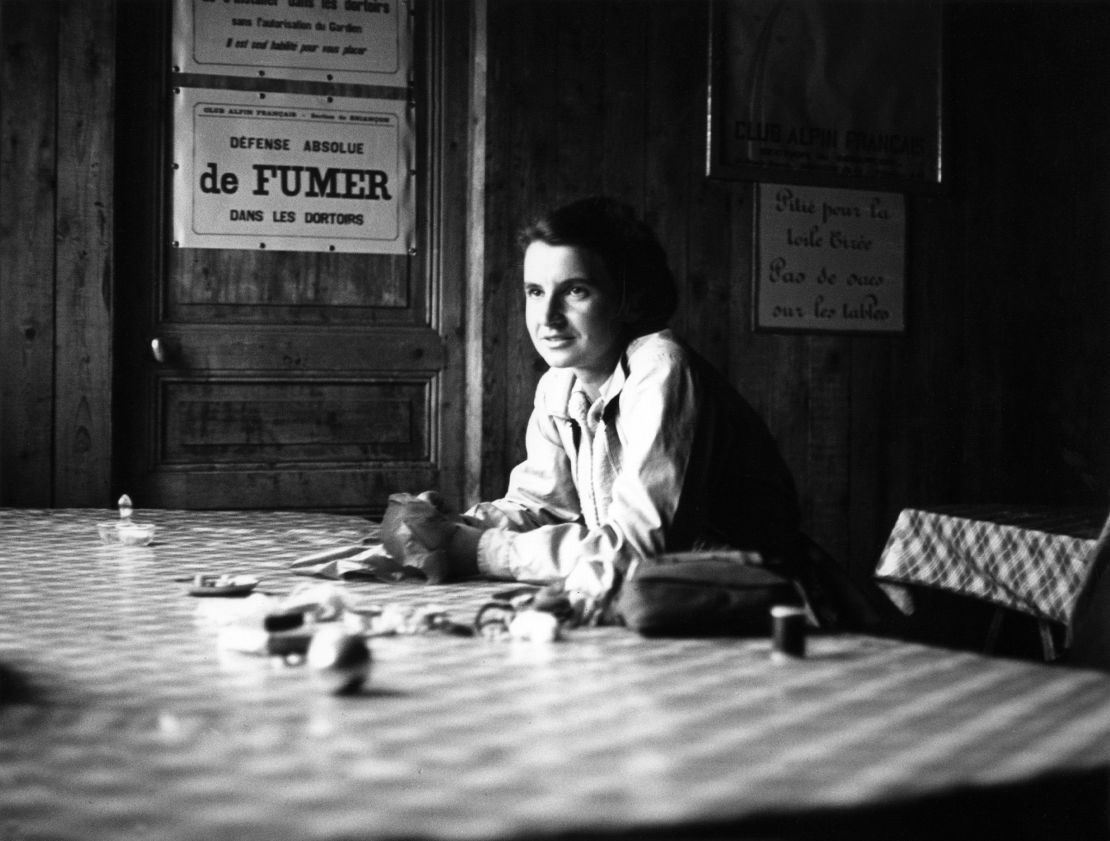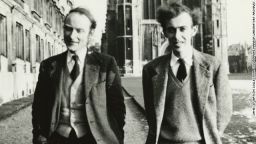Story highlights
James Watson, 85, and Francis Crick figured out DNA has a double helix structure
Watson and Crick shared a 1962 Nobel Prize for the discovery
Watson was also the first director of the Human Genome Project
At 85, James Watson still plays tennis every week. His hips and knees haven’t given out yet, he says, and he likes grass courts.
“I try and play people who can hit the ball hard,” he said Tuesday at Cold Spring Harbor Laboratory, a Long Island, New York, research institution he directed for 25 years.
Watson has always gone up against tough competition, especially in science. Most famously, in 1953, he and Francis Crick figured out that DNA, the molecule of life, has a double helix structure, beating their rival Linus Pauling to the answer.
Solving the DNA structure set the stage for the foundation of much of modern biology, as scientists use insights about DNA to develop disease treatments, trace the inheritance of physical traits and explore how conditions can be passed down from generation to generation.
Having shared the Nobel Prize for the discovery with Crick and Maurice Wilkins in 1962, who are now both deceased, Watson is aware that he perhaps has no competitor in the title of most famous living scientist.
“That’s really saying, there’s not been another DNA,” he said, clad in khaki Bermuda shorts, beige socks and brown loafers. “All you can say is that you were very lucky. You were born at the right time and your parents gave you books when you were young.”
Early life
Watson was born in Chicago in 1928. His father didn’t finish college, and he worked collecting money for a correspondence school.
“I think I was probably lucky to have been raised in the awful days of the Depression and then Hitler, the war,” Watson says. “It made me” – he takes one of his signature long pauses – “Conscious. Don’t make big mistakes. You can lose everything.”
When the geneticist was about 8 years old, he wanted to know how birds migrate. It seemed like a big puzzle to him, one of many throughout his life. He wanted to go into science to understand the world better.
Facts about James Watson
FACTS ABOUT JAMES WATSON
5 cool things DNA testing can do
His parents didn’t expect him to get a job that would take him away from his studies. Occasionally he worked at a drug store fountain, but nothing that would require significant time out of his school work.
Watson did his undergraduate studies at the University of Chicago, which he began after only two years of high school. There, he said, he learned how to think, be confident in his thoughts and push himself in the direction of solving big problems. He says he brought that self-confidence to Indiana University, where he earned a Ph.D.
Watson and Crick
Watson decided he wanted to work on the three-dimensional structures of molecules, a subject that represented a new frontier at the time. There weren’t many labs in the world where such research was being conducted; one of them was the Cavendish Laboratory in Cambridge, England.
Crick, a researcher there, had studied physics, and he was 12 years older than Watson. They had lunch together almost every day.
“He was the first person I met who I could really talk to,” Watson says. “I’d met people, but they didn’t share my conviction that only DNA was important. They were all going and doing experiments which I thought won’t get us anywhere if you’re wanting to know the nature of life. I think, early on, I wanted to do something important with my life.”
They worked on the problem of the structure of DNA for about a year and a half. They made mistakes along the way, but collaborated on figuring out a way to describe genetic material.
The final answer came through models made with cardboard cutouts that Watson prepared. Just the day before he and Crick discovered it, a researcher named Jerry Donohue told Watson he had the chemistry wrong; he’d included chemical bonds that didn’t exist. When Watson changed the chemistry, the model started to make sense.
“I thought I had the answer,” he remembers. “Crick came in and immediately looked and said, ‘It’s the answer.’ We talked about it, we went to lunch, we had to tell people we’d done something important, but they didn’t know what we were saying.”
They would need to build a complete model in order to really declare victory, Watson writes in his memoir “The Double Helix: A Personal Account of the Structure of DNA.” Later they did make one, out of steel and brass. But on the day of the discovery, he felt queasy when he said Crick told “everyone within hearing distance that we had found the secret of life.”
That secret of life, the language of the gene, was wound up in a double helix. The structure of DNA is two twisted strands of deoxyribose sugars and phosphate groups, held together by the bases adenine (A), cytosine (C), guanine (G), and thymine (T). Each A on one strand corresponds to a T on the other, and each C on one strand corresponded to a G on the other. These base pairs are like rungs of a ladder, holding the helical structure together.
“All we could say when we got it: It’s so beautiful!” Watson remembers.
Watson and Crick published their Earth-shattering discovery in the journal Nature in 1953, in an article describing how the two chains were held together by bases. In one of the most iconic understatements of modern science, they wrote, “It has not escaped our notice that the specific pairing we have postulated immediately suggests a possible copying mechanism for the genetic material.”
These insights about how DNA stores information, and how it’s replicated, changed biology forever.
“Everything we do since then is more or less based on that structure,” said Mario Capecchi, professor of genetics and human biology at the University of Utah, who was a graduate student of Watson’s at Harvard University in the 1960s.
…and Franklin?
While Watson and Crick are celebrated worldwide for the discovery, there were other researchers who also worked on the structure of DNA at that time. On this point, the history gets controversial.

Rosalind Franklin and Maurice Wilkins were using a technique called X-ray diffraction to look for the geometry of DNA. In this method, scientists treated the DNA in a certain way so when they shined X-rays on it, they bounced off the sample and created patterns on photographic film. These patterns helped scientists infer the crystal’s structures.
“Photo 51,” which Raymond Gosling created under Franklin’s direction, using this method, indicated the helical structure of DNA to Watson and Crick, according to the official Nobel Prize website. But Watson remembers Franklin and her work differently – it was eight months between her team’s picture and the double helix discovery, and, according to Watson, Franklin did not want to investigate the possibility of a helical structure.
Franklin died at age 37 of ovarian cancer, before the Nobel Prize in physiology or medicine was awarded for the DNA structure discovery. The award is never given posthumously, and Franklin was never nominated, according to the Nobel Prize website.

The important problems
Colleagues of Watson say he’s a big fan of hanging around smart people.
Watson and Crick were a history-making team, but they went their separate ways after the DNA double helix discovery. In 1956, Watson moved to Harvard.
Capecchi remembers that Watson taught him not to limit himself in terms of work that will make a difference.
“One of the mantras that I keep with me: It takes about the same amount of energy to work on a little problem as the big problems, so why waste your time on the little problems?” Capecchi said. “Put your efforts into significant problems.”
Shakespeare, thou art stored in DNA
Watson then directed the Long Island research institution from 1968 to 1993, overseeing its tremendous expansion into education and research, not to mention the installment of a statue of Charles Darwin looking out at the boats.
“We became one of the most prominent cancer researcher places in the country,” said Bruce Stillman, president of Cold Spring Harbor Laboratory. “Just as he was with the double helix, he was a real visionary in running an institution, and how an institution can have an impact on the world.”
The force of Watson’s personality has influenced the development of the lab, said Jan Witkowski, a professor at Cold Spring Harbor Laboratory.
“He didn’t tolerate fools,” Witkowski said. “That includes in meetings.”
Watson has been quoted in the past making controversial, unscientific claims about sensitive matters.
“He thinks very, very out of the box, and I think that’s one of the penalties you get for thinking out loud about things and wondering about them,” Stillman said. “He challenges people to think about issues, and you get into trouble doing that.”
Watson also was the first director of the Human Genome Project, an international project aiming to sequence the human genome, but resigned in 1992. The project ended in 2003, establishing the order of the 3 billion letters in the genome, which can be thought of as “the book of life.”
Between insights from the genome project and the double helix structure, DNA has proved to be important in surprising areas, Watson said, from DNA fingerprinting to diagnosing risk for genetic disease. DNA will probably be essential in future cures for cancer, because cancer arises from changes in DNA, Watson said.
“I don’t want to die until I see cancer cured,” he said with a laugh. “Because I think it could happen.”
Watson today
On the sunny grounds of Cold Spring Harbor, Watson dons a white floppy hat and glasses. These days, he’s interested in how exercise prevents disease such as cancer, and says he has some unpopular ideas about antioxidants and diet.
Cold case cops find new DNA strategy
Among Watson’s current activities is writing a book about his father and his family called “Father to Son.” He’s learned that he descended from a Watson living in Springfield, Illinois, who decided to go on the Gold Rush.
When this ancestral Watson returned, he established a confectionery store where – according to James Watson – Abraham Lincoln used to buy desserts. The ancestor also founded a large resort hotel in the Midwest, which wouldn’t have happened unless he’d taken a big chance to go look for gold.
As far as Watson, “DNA was my only gold rush,” he said. “I regarded DNA as worth a gold rush.”
Besides genetics and curing cancer, Watson has been thinking about his age. He used to not want to get to 90 because it’s “hard to find role models” among that age group, and now he finds it hard to find desirable conversation partners among his peers.
“The brain doesn’t have to…” Here he pauses and looks up at the ceiling.
“… sort of, be unimaginative when you’re older, but you almost have to move in a world where people are young, to make you think that way.”








